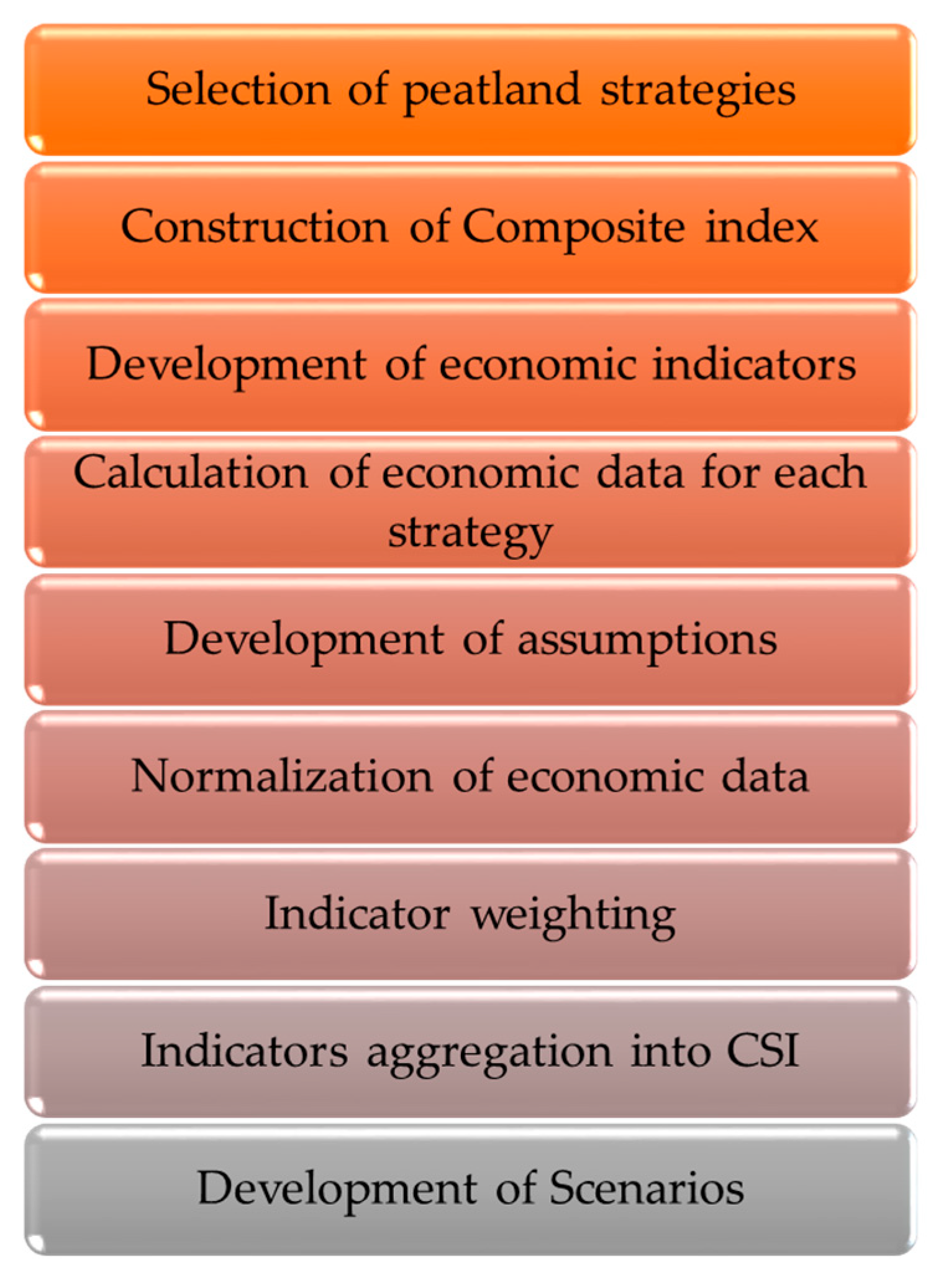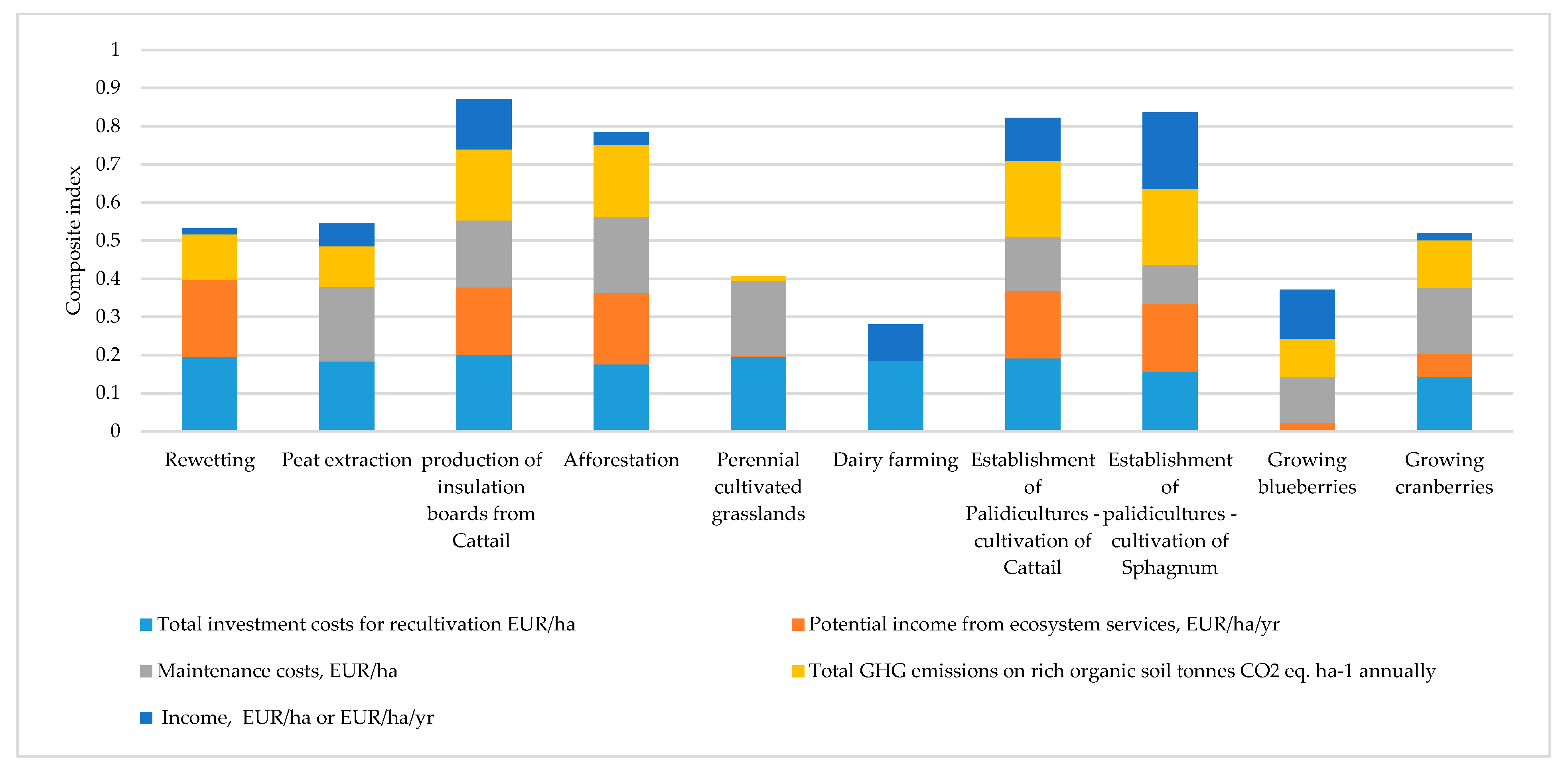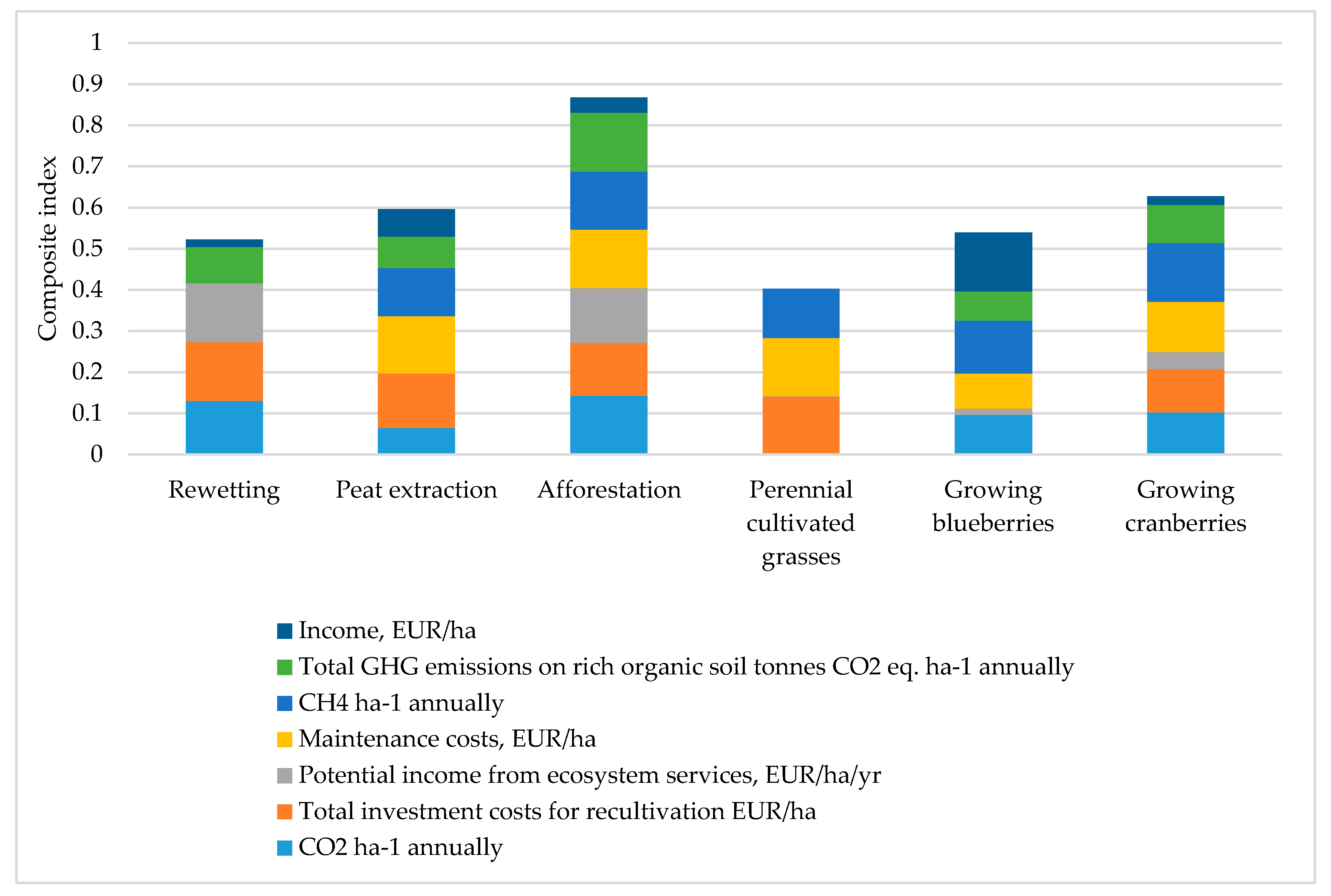Comparison of the Economic and Environmental Sustainability for Different Peatland Strategies
Abstract
:1. Introduction
2. Greenhouse Gas Emissions from Peatlands and Economic Aspects of Peat
2.1. Main Greenhouse Gas Emission and Economic Aspects of Peatland Strategies
2.1.1. Peatland Rewetting
2.1.2. Paludiculture
Peat Biomass Options for High-Added-Value Products
2.1.3. Afforestation of Peatlands
2.1.4. Perennial Cultivated Grasslands
2.1.5. Water Reservoir
2.1.6. Growing Cranberries and Blueberries
2.1.7. Peat Extraction
2.1.8. Dairy Farming on Peat Soils
3. Materials and Methods
3.1. Framework of the Study
- Suitable economic indicators, divided into two groups—(1) necessary costs, (2) incomes and possible gains from grants and subsidies, etc.
- GHG emissions of each strategy.
3.2. Selection of Strategies
3.3. Development of Indicators
3.4. Economic and Environmental Data for Each Strategy
- Establishment of paludicultures—the cultivation of cattail: 7300/ha EUR [44].
- Establishment of paludicultures—the cultivation of sphagnum: capital investments 23,300/ha EUR [44]
3.5. Normalization of Data
3.6. Indicator Weighting
- A total of 5 indicators were used with a weight 0.20 for each indicator.
- A total of 7 indicators were used with a weight 0.14 for each indicator.
3.7. Indicators Aggregation into CI
4. Results
5. Discussion
Limitations of the Study
6. Conclusions
Author Contributions
Funding
Data Availability Statement
Conflicts of Interest
Nomenclature
| GHG | Greenhouse gas |
| CO2 | Carbon dioxide |
| EU | European Union |
| Ha | Hectare |
| EUR/ha | EUR per hectare |
References
- Greifswald Mire Centre. Exchange of Views on Post 2020 CAP and Its Effect on Farming on Organic (Peat) Soils Report. 2020. Available online: www.repeat-project.com (accessed on 22 March 2024).
- Evans, B. Economics of Peatlands Conservation, Restoration and Sustainable Management Economics of Peatlands Conservation, Restoration and Sustainable Management Policy Report; United Nations Environment Programme: Nairobi, Kenya, 2021. [Google Scholar]
- He, H.; Roulet, N.T. Improved estimates of carbon dioxide emissions from drained peatlands support a reduction in emission factor. Commun. Earth Environ. 2023, 4, 436. [Google Scholar] [CrossRef]
- Greifswald Mire Centre and Wetlands International Europe. Higher Ambition for Peatlands in the EU Nature Restoration Law Proposal. Policy Briefing. 2022. Available online: https://europe.wetlands.org/publications/higher-ambition-for-peatlands-in-the-eu-nature-restoration-law-proposal/ (accessed on 7 April 2024).
- Gren, I.-M. A trading market for uncertain carbon removal by land use in the EU. For. Policy Econ. 2024, 159, 103127. [Google Scholar] [CrossRef]
- Minasny, B.; Adetsu, D.V.; Aitkenhead, M.; Artz, R.R.E.; Baggaley, N.; Barthelmes, A.; Beucher, A.; Caron, J.; Conchedda, G.; Connolly, J.; et al. Mapping and monitoring peatland conditions from global to field scale. Biogeochemistry 2023, 1–43. [Google Scholar] [CrossRef]
- Stivrins, N.; Bikše, J.; Jeskins, J.; Ozola, I. Hands-On Approach to Foster Paludiculture Implementation and Carbon Certification on Extracted Peatland in Latvia. Land 2024, 13, 188. [Google Scholar] [CrossRef]
- Kaleja, S.; Bardule, A. Review of climate change mitigation measures applicable in degraded peatlands in Latvia. In Research for Rural Development 2022, Proceedings of the Annual 28th International Scientific Conference Proceedings, Jelgava, Latvia, 18–20 May 2022; Latvia University of Life Sciences and Technologies: Jelgava, Latvia, 2022; Volume 37, pp. 56–62. [Google Scholar] [CrossRef]
- Greifswald Mire Centre. Briefing Paper on the Role of Peatlands in the New European Union’s Common Agriculture Policy (CAP). 2019. Available online: https://greifswaldmoor.de/files/dokumente/Infopapiere_Briefings/GMC-briefing%20paper_CAP_final.pdf (accessed on 25 March 2024).
- Wichmann, S. Economic incentives for climate smart agriculture on peatlands in the EU. In Proceedings of the Greifswald Mire Centre; Greifswald Mire Centre: Greifswald, Germany, 2018; Volume 1, Available online: www.greifswaldmoor.de (accessed on 10 October 2023).
- European Court of Auditors. Common Agricultural Policy and Climate—Half of EU Climate Spending but Farm Emissions Are Not Decreasing; Curia Rationum: Luxembourg, 2021; pp. 1–65. [Google Scholar]
- Ozola, I.; Dauskane, I.; Aunina, I.; Stivrins, N. Paludiculture in Latvia—Existing Knowledge and Challenges. Land 2023, 12, 2039. [Google Scholar] [CrossRef]
- Strategy for Responsible Peatland Management. 2019. Available online: www.peatlands.org (accessed on 15 November 2023).
- VARAM Develop ‘Guidelines for the Sustainable Use of Peat 2020-2030′|Vides Aizsardzības un Reģionālās Attīstības Ministrija. Available online: https://www.varam.gov.lv/en/article/varam-develop-guidelines-sustainable-use-peat-2020-2030 (accessed on 4 December 2023).
- Horsburgh, N.; Tyler, A.; Mathieson, S.; Wackernagel, M.; Lin, D. Biocapacity and cost-effectiveness benefits of increased peatland restoration in Scotland. J. Environ. Manag. 2022, 306, 114486. [Google Scholar] [CrossRef] [PubMed]
- Artz, R.R.E.; Faccioli, M.; Roberts, M.; Anderson, R. Peatland Restoration—A Comparative Analysis of the Costs and Merits of Different Restoration Methods. 2018. Available online: www.climatexchange.org.uk (accessed on 31 August 2023).
- Moxey, A.; Moran, D. UK peatland restoration: Some economic arithmetic. Sci. Total Environ. 2014, 484, 114–120. [Google Scholar] [CrossRef] [PubMed]
- Moxey, A. Assessing the Opportunity Costs Associated with Peatland Restoration; National Committee United Kingdom: London, UK, 2016. [Google Scholar]
- Glenk, K.; Martin-Ortega, J. The economics of peatland restoration. J. Environ. Econ. Policy 2018, 7, 345–362. [Google Scholar] [CrossRef]
- Rhymes, J.M.; Arnott, D.; Chadwick, D.R.; Evans, C.D.; Jones, D.L. Assessing the effectiveness, practicality and cost effectiveness of mitigation measures to reduce greenhouse gas emissions from intensively cultivated peatlands. Land Use Policy 2023, 134, 106886. [Google Scholar] [CrossRef]
- Mathias, Y. Financing Mechanisms in Europe for Restoring Peatlands; European Union: Brussels, Belgium, 2022. [Google Scholar]
- Martin, N.; Couwenberg, J. Organic Soils in National Inventory Submissions of EU Countries. 2021. Available online: www.greifswaldmoor.de (accessed on 25 March 2024).
- Thers, H.; Knudsen, M.T.; Lærke, P.E. Comparison of GHG emissions from annual crops in rotation on drained temperate agricultural peatland with production of reed canary grass in paludiculture using an LCA approach. Heliyon 2023, 9, e17320. [Google Scholar] [CrossRef]
- Grootjans, A.P. Paludiculture—Productive Use of Wet Peatlands. Restor. Ecol. 2017, 25, 661–663. [Google Scholar] [CrossRef]
- The Cost of Peatland Restoration in Scotland|SEFARI. Available online: https://sefari.scot/research/the-cost-of-peatland-restoration-in-scotland (accessed on 22 September 2023).
- Makrickas, E.; Manton, M.; Angelstam, P.; Grygoruk, M. Trading wood for water and carbon in peatland forests? Rewetting is worth more than wood production. J. Environ. Manag. 2023, 341, 117952. [Google Scholar] [CrossRef]
- Par Kūdras Ilgtspējīgas Izmantošanas Pamatnostādnēm 2020–2030. Gadam. Available online: https://likumi.lv/ta/id/319013-par-kudras-ilgtspejigas-izmantosanas-pamatnostadnem-20202030-gadam (accessed on 7 December 2023).
- Greifswald Mire Centre. Peatland methane emissions and climate protection. Nat. Commun. 2020, 11, 1644. [Google Scholar] [CrossRef] [PubMed]
- Priede, A.; Authors, A.G.; Aleksāns, O. Sustainable and Responsible after-Use of Peat Extraction Areas Editors. 2019. Available online: www.silava.lv (accessed on 22 November 2023).
- Sechi, V.; van Bell, J.; Fritz, C.; Tilak, A.; Geurts, J.; Roehrig, N.; Nailon, P.; Cartmell-Done, K.; Liu, W.; Smits, T.; et al. Towards a Carbon Credit & Blue Credit Scheme for Peatlands; European Union: Brussels, Belgium, 2021. [Google Scholar]
- Günther, A.; Böther, S.; Couwenberg, J.; Hüttel, S.; Jurasinski, G. Profitability of Direct Greenhouse Gas Measurements in Carbon Credit Schemes of Peatland Rewetting. Ecol. Econ. 2018, 146, 766–771. [Google Scholar] [CrossRef]
- Poppe, K.; van Duinen, L.; de Koeijer, T. Reduction of Greenhouse Gases from Peat Soils in Dutch Agriculture. EuroChoices 2021, 20, 38–45. [Google Scholar] [CrossRef]
- O’Brolchain, N.; Peters, J.; Tanneberger, F. CAP Policy Brief Peatlands in the New European Union Version 4.8; Greifswald Mire Centre: Greifswald, Germany, 2020; pp. 5–8. Available online: https://www.nhbs.com/paludiculture-productive-use-of-wet-peatlands-book (accessed on 22 March 2024).
- De Jong, M.; van Hal, O.; Pijlman, J.; van Eekeren, N.; Junginger, M. Paludiculture as paludifuture on Dutch peatlands: An environmental and economic analysis of Typha cultivation and insulation production. Sci. Total Environ. 2021, 792, 148161. [Google Scholar] [CrossRef] [PubMed]
- Tanneberger, F.; Birr, F.; Couwenberg, J.; Kaiser, M.; Luthardt, V.; Nerger, M.; Pfister, S.; Oppermann, R.; Zeitz, J.; Beyer, C.; et al. Saving soil carbon, greenhouse gas emissions, biodiversity and the economy: Paludiculture as sustainable land use option in German fen peatlands. Reg. Environ. Chang. 2022, 22, 69. [Google Scholar] [CrossRef]
- Doelman, J.C.; Stehfest, E.; van Vuuren, D.P.; Tabeau, A.; Hof, A.F.; Braakhekke, M.C.; Gernaat, D.E.H.J.; Berg, M.v.D.; van Zeist, W.; Daioglou, V.; et al. Afforestation for climate change mitigation: Potentials, risks and trade-offs. Glob. Chang. Biol. 2020, 26, 1576–1591. [Google Scholar] [CrossRef] [PubMed]
- Skrastiņa, E.; Straupe, I.; Lazdiņš, A. Afforestation of Abandoned Peat Extraction Sites with Scots Pine (Pinus sylvestris L.) as a Solution of Climate Change Mitigation. In Research for Rural Development 2021, Proceedings of the Annual 27th International Scientific Conference Proceedings, Jelgava, Latvia, 12–14 May 2021; Latvia University of Life Sciences and Technologies: Jelgava, Latvia, 2021. [Google Scholar] [CrossRef]
- IUCN National Committee United Kingdom. IUCN UK Committee Peatland Programme Briefing Note No 6 Commercial Peat Extraction; IUCN National Committee United Kingdom: London, UK, 2014. [Google Scholar]
- Vanags-Duka, M.; Bārdule, A.; Butlers, A.; Upenieks, E.M.; Lazdiņš, A.; Purviņa, D.; Līcīte, I. GHG Emissions from Drainage Ditches in Peat Extraction Sites and Peatland Forests in Hemiboreal Latvia. Land 2022, 11, 2233. [Google Scholar] [CrossRef]
- Liu, W.; Fritz, C.; van Belle, J.; Nonhebel, S. Production in peatlands: Comparing ecosystem services of different land use options following conventional farming. Sci. Total Environ. 2023, 875, 162534. [Google Scholar] [CrossRef] [PubMed]
- IUCN UK Peatland Programme. Principles for Sustainable Peatland Paludiculture; IUCN UK Peatland Programme: Edinburgh, UK, 2023. [Google Scholar]
- LIFE REstore—OPTIMIZĀCIJAS MODELIS. Available online: https://restore.daba.gov.lv/public/lat/optimizacijas_modelis1/ (accessed on 5 December 2023).
- Normatīvie Akti—LĪVA. Available online: https://www.vertetaji.lv/normativie-akti (accessed on 5 December 2023).
- Colbers, B.; Cornelis, S.; Geraets, E.; Gutiérrez-Valdés, N.; Tran, L.M.; Moreno-Giménez, E.; Ramírez-Gaona, M. A Feasibility Study on the Usage of Cattail (Typha spp.) for the Production of Insulation Materials and Bio-Adhesives; Wageningen University and Research Centre: Wageningen, The Netherlands, 2017. [Google Scholar]
- Afforestation and Reforestation as Adaptation Opportunity. Available online: https://climate-adapt.eea.europa.eu/en/metadata/adaptation-options/afforestation-and-reforestation-as-adaptation-opportunity (accessed on 16 January 2024).
- Lazdiņš, A.; Lupiķis, A. 2019. LIFE REStore projekta pienesums Latvijas siltumnīcefekta gāzu emisiju uzskaitē. Grām.: Priede A., Gancone A. (red.) 2019. Kūdras ieguves ietekmētu teritoriju atbildīga apsaimniekošana un ilgtspējīga izmantošana. Baltijas krasti, Rīga. Available online: https://www.latvijaskudra.lv/upload/life_restore_gramata_1.pdf (accessed on 5 December 2023).
- KPMG Baltics SIA. Publiskas Personas Zemes Nomas Maksas Noteikšanas Metodika Derīgo Izrakteņu Ieguves Teritorijām; KPMG Baltics SIA: Rīga, Latvia, 2023. [Google Scholar]
- Balode, L.; Dolge, K.; Blumberga, D. The Contradictions between District and Individual Heating towards Green Deal Targets. Sustainability 2021, 13, 3370. [Google Scholar] [CrossRef]
- Lemke, C.; Bastini, K. Embracing multiple perspectives of sustainable development in a composite measure: The Multilevel Sustainable Development Index. J. Clean. Prod. 2020, 246, 118884. [Google Scholar] [CrossRef]
- Razmjoo, A.A.; Sumper, A.; Davarpanah, A. Development of sustainable energy indexes by the utilisation of new indicators: A comparative study. Energy Rep. 2019, 5, 375–383. [Google Scholar] [CrossRef]
- Aarhus University. Emission Factors per GJ Fuel Input. Available online: https://envs.au.dk/fileadmin/envs/Emission_inventories/Emission_factors/Emf_internet_energy_GHG.htm (accessed on 8 May 2023).
- Chapman, S.; Thomson, K.; Matthews, R. AFOLU Accounting: Implication for Implementing Peatland Restoration—Costs and Benefits. 2012. Available online: www.climatexchange.org.uk (accessed on 11 January 2024).
- Bansal, S.; Lishawa, S.C.; Newman, S.; Tangen, B.A.; Wilcox, D.; Albert, D.; Anteau, M.J.; Chimney, M.J.; Cressey, R.L.; DeKeyser, E.; et al. Typha (Cattail) Invasion in North American Wetlands: Biology, Regional Problems, Impacts, Ecosystem Services, and Management. Wetlands 2019, 39, 645–684. [Google Scholar] [CrossRef]
- Abel, S.; Hallweit, T. Potential Paludiculture Plants of the Holarctic. Available online: https://www.researchgate.net/publication/365853219_Potential_Paludiculture_Plants_of_the_Holarctic (accessed on 2 November 2023).
- Wichmann, S.; Prager, A.; Gaudig, G. Establishing Sphagnum cultures on bog grassland, cut-over bogs, and floating mats: Procedures, costs and area potential in Germany. Mires Peat 2017, 20, 1–19. [Google Scholar] [CrossRef]
- Makovskis, K.; Lazdina, D.; Popluga, D. Cut-Away Peatland Re-Cultivation with Fast Growing Woody Plantations: Cost-Benefit Analysis. Rural Dev. 2019, 2019, 305–312. [Google Scholar] [CrossRef]
- Stachowicz, M.; Manton, M.; Abramchuk, M.; Banaszuk, P.; Jarašius, L.; Kamocki, A.; Povilaitis, A.; Samerkhanova, A.; Schäfer, A.; Sendžikaitė, J.; et al. To store or to drain—To lose or to gain? Rewetting drained peatlands as a measure for increasing water storage in the transboundary Neman River Basin. Sci. Total Environ. 2022, 829, 154560. [Google Scholar] [CrossRef] [PubMed]
- Van Boxmeer, E.; Modernel, P.; Viets, T. NC-ND license Environmental and economic performance of Dutch dairy farms on peat soil. Agric. Syst. 2021, 193, 103243. [Google Scholar] [CrossRef]
- Lyons, K.G.; Török, P.; Hermann, J.-M.; Kiehl, K.; Kirmer, A.; Kollmann, J.; Overbeck, G.E.; Tischew, S.; Allen, E.B.; Bakker, J.D.; et al. Challenges and opportunities for grassland restoration: A global perspective of best practices in the era of climate change. Glob. Ecol. Conserv. 2023, 46, e02612. [Google Scholar] [CrossRef]
- Written Evidence Submitted by the IUCN UK Peatland Programme. Available online: http://www.iucn-uk-peatlandprogramme.org/ (accessed on 22 September 2023).
- Nicholson, E.; Watermeyer, K.E.; Rowland, J.A.; Sato, C.F.; Stevenson, S.L.; Andrade, A.; Brooks, T.M.; Burgess, N.D.; Cheng, S.-T.; Grantham, H.S.; et al. Scientific foundations for an ecosystem goal, milestones and indicators for the post-2020 global biodiversity framework. Nat. Ecol. Evol. 2021, 5, 1338–1349. [Google Scholar] [CrossRef] [PubMed]
- Nordbeck, R.; Hogl, K. National peatland strategies in Europe: Current status, key themes, and challenges. Reg. Environ. Chang. 2024, 24, 5. [Google Scholar] [CrossRef]



| 1. Restoration strategies |
| Peatland rewetting |
| Afforestation of peatlands |
| Perennial cultivated grasses |
| Paludiculture (1) cattail (typha; (2) sphagnum farming) |
| Water reservoir |
| Growing cranberries |
| Growing blueberries |
| 2. Peat biomass use in high added value product Production of insulation boards from cattail-based on paludicultures [1] |
| 3. Other land use—dairy farming on peat soils |
| 4. Peat extraction |
| No | Indicator | Units | Indicator Description | Impact |
|---|---|---|---|---|
| i1 | Total investment costs to implement strategy | EUR/ha | The indicator considers recultivation planning, recultivation, construction costs, and exploitation costs in each of the alternatives. | - |
| i2 | Maintenance costs | EUR/ha | Maintenance costs, including deprecation costs and monitoring costs. | - |
| i3 | Income | EUR/ha | Annual profits (including economic value from products), total revenues, EUR/tonnes, subsidies, and grants for a specific strategy. | + |
| i4 | Potential income from ecosystem services | EUR/ha/yr | The indicator describes alternative monetary value: potential income from ecosystem services. Calculations based on The Project Life Restore optimisation model additionally take into account inflation and assumptions. Ecosystem services provide some benefit—tangible or intangible. A forest provides wood, and a peatland provides peat; therefore, both are material services. | + |
| i5 | CO2 | ha−1/yr | Carbon dioxide emissions | - |
| i6 | CH4 | ha−1/yr | Methane emissions | - |
| i7 | Total GHG emissions on rich organic soil | CO2-eq ha−1 yr−1 | Total GHG emissions | - |
| Rewetting | Peat Extraction | Production of Insulation Boards from Cattail Based on Paludicultures | Afforestation | Perennial Cultivated Grasses | Dairy Farming | Establishment of Palidicultures—The Cultivation of Cattail | Establishment of Paludicultures—The Cultivation of Sphagnum | Growing Blueberries | Water Reservoir | Growing Cranberries | |
|---|---|---|---|---|---|---|---|---|---|---|---|
| I1 Total investments, EUR/ha | 5171 Calculation based on [42] | 11,868 Calculation based on [43] | 3400 Calculation based on [44] | 14,368 Calculation based on [42] | 6087 Calculation based on [42] | 10,570 Calculation based on [44] | 7300 Calculation based on [44] | 23,300 Calculation based on [44] | 96,264 Calculation based on [42] | 7265 Calculation based on [42] | 29,479 Calculation based on [42] |
| I2 Potential income from ecosystem services, EUR/ha/yr | 49,308 Calculation based on [42] | 665 * Calculation based on [43] | 43,825 * Calculation based on [42] | 45,908 Calculation based on [42] | 899.6 Calculation based on [42] | 0.001 | 43,825 [42] | 43,825.3 Calculation based on [42] | 5696 Calculation based on [42] | 35,967 Calculation based on [42] | 14,693 Calculation based on [42] |
| I3 Maintenance costs, EUR/ha | 10,338 (including monitoring costs) [30] | 425. Calculation based on [43] | 1400. Calculation based on [44] | 157 Calculation based on [42] | 261.8 Calculation based on [42] | 4035. Calculation based on [44] | 3170 Calculation based on [44] | 5175 Calculation based on [44] | 4215. Calculation based on [42] | 0.001 | 1597 Calculation based on [42] |
| I4 Income, EUR/ha | 1442 Calculations based on average on-time payments and carbon credit | 3914.9 Calculation based on [43] | 7966.7 Calculation based on [44] | 2400 [45] | 497.5 Calculation based on [42] | 5965 Calculation based on [44] | 6896.7 Calculation based on [44] | 11,891.7 Calculation based on [44] | 7854 Calculation based on [42] | 0.001 Calculation based on [42] | 1570.8 Calculation based on [42] |
| CO2 | 2 based on [46] | 7 based on [46] | 1 based on [46] | 12 based on [46] | 5 based on [46] | 4 based on [46] | |||||
| CH4 | 7.2 based on [46] | 1.4 based on [46] | 0.3 based on [46] | 1.3 based on [46] | 0.9 based on [46] | 0.2 based on [46] | |||||
| Total GHG emissions on rich organic soil CO2-eq ha−1 yr−1 | 9.9 [46] | 11.2 [46] | 3.9 [34] | 3.7 [46] | 19.9 [46] | 20.9 [34] | 2.6 [46] | 2.6 [46] | 11.8 based on [46] | 9.3 based on [46] |
Disclaimer/Publisher’s Note: The statements, opinions and data contained in all publications are solely those of the individual author(s) and contributor(s) and not of MDPI and/or the editor(s). MDPI and/or the editor(s) disclaim responsibility for any injury to people or property resulting from any ideas, methods, instructions or products referred to in the content. |
© 2024 by the authors. Licensee MDPI, Basel, Switzerland. This article is an open access article distributed under the terms and conditions of the Creative Commons Attribution (CC BY) license (https://creativecommons.org/licenses/by/4.0/).
Share and Cite
Balode, L.; Blumberga, D. Comparison of the Economic and Environmental Sustainability for Different Peatland Strategies. Land 2024, 13, 518. https://doi.org/10.3390/land13040518
Balode L, Blumberga D. Comparison of the Economic and Environmental Sustainability for Different Peatland Strategies. Land. 2024; 13(4):518. https://doi.org/10.3390/land13040518
Chicago/Turabian StyleBalode, Lauma, and Dagnija Blumberga. 2024. "Comparison of the Economic and Environmental Sustainability for Different Peatland Strategies" Land 13, no. 4: 518. https://doi.org/10.3390/land13040518
APA StyleBalode, L., & Blumberga, D. (2024). Comparison of the Economic and Environmental Sustainability for Different Peatland Strategies. Land, 13(4), 518. https://doi.org/10.3390/land13040518






